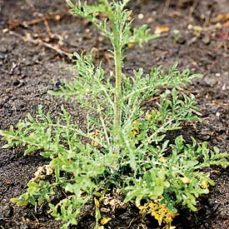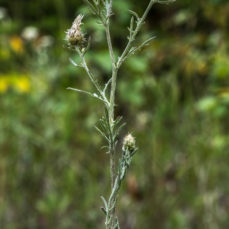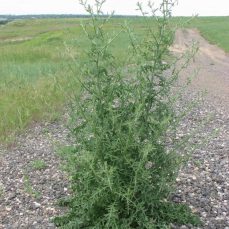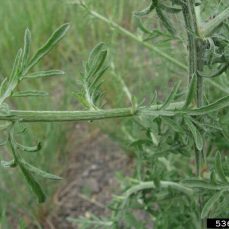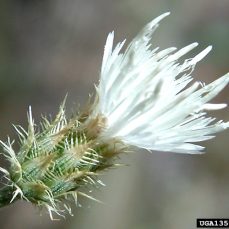Diffuse knapweed (Centaurea diffusa)

Photo credit: Bryan Kelly-McArthur

Management Strategy
Squamish
Whistler
Pemberton
Vectors of Spread
Synonyms
Diffuse knapweed is also known as:
- White knapweed
- Tumble knapweed
- Spreading knapweed
- Actosa diffusa
ID Characteristics
General: Diffuse knapweed is a biennial or short-lived perennial that grows up to 1 m tall.
Flowers: Small, white, sometimes rose-purple or lavender. Flowers form alone or in clusters at the end of branches. They have small, sharp, rigid spines on the bracts.
Stems: Single, upright stem with multiple branches. Stems have short, stiff white hairs.
Leaves: Upper leaves are stalkless and become bract-like near the flowers. The rosette and lower leaves are 5 – 20 cm long, rough, grey-green, hairy and divided. They grow in an alternate arrangement along the stem.
Seeds: Light brown to black, about 3 mm long.
Roots: Deep taproot.
Similar Species
Invasive

- Spotted knapweed (Centaurea stoebe) has hairy, deeply-cut leaves with the lower leaves having a black-tipped fringe, which gives it its spotted appearance. Flowers are purple (white on occasion) on a single or multiple upright stems that can grow to 1 m tall. A single plant can produce up to 140,000 seeds. Spotted knapweed prefers moist habitats as well as disturbed areas.
Habitat and Origin
Diffuse knapweed was brought to North America as a contaminant in crop seeds. It was first introduced to BC in 1936.
Diffuse knapweed grows in disturbed, dry areas such as sandy areas, grasslands, pastures, woodland clearings, open forests, roadsides, right-of-ways and clear-cuts. It is intolerant of moist soils, flooding and shade.
How it Spreads
Diffuse knapweed reproduces solely by seed. Dormant seeds can remain viable in the soil for over 15 years. A single plant can produce up to 18,000 seeds, and infested areas can have seed banks of up to 40,000 seeds per square meter.
Diffuse knapweed spreads solely by seed, which break off when mature and tumble in the wind; the seeds can spread up to 100 m from the parent plant. Seeds can also be spread by wildlife, livestock and humans via hay and vehicle undercarriages. In BC, logging trucks and off-road vehicles have been a major vector of spread.
Impacts
Environmental:
- Outcompetes and replaces native forage plants on range and pasturelands. While diffuse knapweed is not poisonous, it can lead to reduced nutrition for livestock and wildlife.
- Mature knapweed plants are coarse and the spines on the bracts can irritate or injure the mouths and digestive tracts of grazing animals.
- Can deplete soil and water resources.
- Displays allelopathic properties, inhibiting other plants from growing.
- Reduces biodiversity.
Economic:
- Reduces land values and increases road maintenance costs.
Stop the Spread
Diffuse knapweed is abundant in certain portions of the Sea to Sky region, but it has not yet infested all potential habitats. The goal is to contain the spread of diffuse knapweed to Pemberton / ISMA 3.
Learn how to identify diffuse knapweed: Use the images presented on this profile page.
What to do if you spot it: You can report any diffuse knapweed sighting by visiting our reporting page.
DO:
- Regularly monitor properties for weed infestations.
- Remove plant material from any equipment, vehicles or clothing used in infested areas and wash equipment and vehicles at designated cleaning sites before leaving infested areas.
- Ensure soil and gravel are uncontaminated before transport.
- Minimize soil disturbances (e.g., use grazing plants that prevent soil exposure from overgrazing), and use seed mixes with dense, early colonization (e.g., alfalfa or barley) to re-vegetate exposed soil and resist invasion.
- Ensure invasive plant (particularly flowering heads or root fragments) are bagged or covered to prevent spread during transport to designated disposal sites (e.g., landfill). Do NOT compost.
DO NOT:
- Plant diffuse knapweed in a garden, no matter how well-contained its enclosure may seem.
- Move soil that has been contaminated with diffuse knapweed.
- Unload, park, or store equipment or vehicles in infested areas; remove plant material from any equipment, vehicles, or clothing used in such areas and wash equipment and vehicles at designated cleaning sites before leaving infested areas.
- Compost diffuse knapweed, especially the seeds!
Control
Cultural Control:
Grazing by sheep and goats has been found to suppress knapweed growth.
Mechanical Control:
- Repeated hand-pulling and digging before flowering can be effective on small infestations, but must be done over several years.
- Make sure to wear gloves and a long sleeve shirt as Diffuse Knapweed is abrasive and can cause skin irritation.
- Mowing also prevents seed production but the remaining root will re-sprout.
Chemical Control:
- Foliar application of dicamba, 2, 4-D, clopyralid, aminopyralid or glyphosate are effective forms of control.
- Picloram is also very effective, but not appropriate in moist, coastal soils.
We recommend that any herbicide application is carried out by a person holding a valid BC Pesticide Applicator Certificate. Before selecting and applying herbicides, you must review and follow herbicide labels and application rates; municipal, regional, provincial and federal laws and regulations; species-specific treatment recommendations, and site-specific goals and objectives.
Biological Control:
There are 12 biocontrol agents used in the Mainland and Coast regions of BC. Biocontrol helps decrease the size and vigour of plants, as well as their seed production, but it is not considered an eradication method.
Sea to Sky Distribution
Diffuse Knapweed Factsheet
Having trouble viewing the factsheet? Don’t worry, all the information is included on this page. You can also contact us with any questions.
Additional Resources
References
- Alberta Invasive Species Council, Diffuse Knapweed Factsheet
- Central Kootenay Invasive Species Society, Diffuse Knapweed
- Electronic Atlas of the Flora of British Columbia, Centaura diffusa
- Fraser Valley Invasive Species Society, Diffuse Knapweed
- Gayton, Don & Miller, Val, Impact of Biological Control on Two Knapweed Species in British Columbia, Journal of Ecosystems and Management, vol. 13, no. 3 (2012)
- Government of BC, Field Guide to the Biological Control of Weeds in British Columbia
- Invasive Species Compendium (CABI), Centaurea diffusa (diffuse knapweed)
- Invasive Species Council of BC, Diffuse Knapweed
- Invasive Species Council of BC, How Biocontrol Took Down Diffuse Knapweed
- Invasive Species Council of BC, Knapweeds TIPS Factsheet
- US Department of Agriculture National Invasive Species Information Center, Diffuse Knapweed







